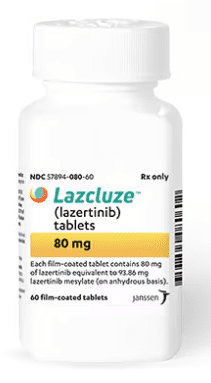Lazcluze and Alcohol/Food Interactions
There is 1 alcohol/food/lifestyle interaction with Lazcluze (lazertinib).
Lazertinib Food/Lifestyle
Minor Food Interaction
Grapefruit juice may theoretically increase plasma levels of lazertinib, as it does with other drugs metabolized by the CYP450 3A4 enzyme. The proposed mechanism is inhibition of CYP450 3A4-mediated first-pass metabolism in the gut wall by certain compounds present in grapefruits. However, the clinical relevance of this potential interaction remains unclear. Studies with strong CYP450 3A4 inhibitors, such as itraconazole, have shown a 1.5-fold increase in the area under the plasma concentration-time curve (AUC) of lazertinib, without any significant changes to the drug's overall safety profile.
References (7)
- Bailey DG, Arnold JMO, Spence JD (1994) "Grapefruit juice and drugs - how significant is the interaction." Clin Pharmacokinet, 26, p. 91-8
- Yamreudeewong W, Henann NE, Fazio A, Lower DL, Cassidy TG (1995) "Drug-food interactions in clinical practice." J Fam Pract, 40, p. 376-84
- Bailey DG, Malcolm J, Arnold O, Spence JD (1998) "Grapefruit juice-drug interactions." Br J Clin Pharmacol, 46, p. 101-10
- Gunston GD, Mehta U (2000) "Potentially serious drug interactions with grapefruit juice." S Afr Med J, 90, p. 41
- (2024) "Product Information. Lazcluze (lazertinib)." Janssen Biotech, Inc.
- (2025) "Product Information. Lazcluze (lazertinib)." Janssen-Cilag Ltd
- (2025) "Product Information. Lazcluze (lazertinib)." Janssen-Cilag Pty Ltd
Switch to consumer interaction data
Lazcluze drug interactions
There are 438 drug interactions with Lazcluze (lazertinib).
Lazcluze disease interactions
There are 4 disease interactions with Lazcluze (lazertinib) which include:
More about Lazcluze (lazertinib)
- Lazcluze consumer information
- Check interactions
- Compare alternatives
- Pricing & coupons
- Drug images
- Side effects
- Dosage information
- During pregnancy
- FDA approval history
- Drug class: EGFR inhibitors
- En español
Related treatment guides
Drug Interaction Classification
| Highly clinically significant. Avoid combinations; the risk of the interaction outweighs the benefit. | |
| Moderately clinically significant. Usually avoid combinations; use it only under special circumstances. | |
| Minimally clinically significant. Minimize risk; assess risk and consider an alternative drug, take steps to circumvent the interaction risk and/or institute a monitoring plan. | |
| No interaction information available. |
See also:
Further information
Always consult your healthcare provider to ensure the information displayed on this page applies to your personal circumstances.


